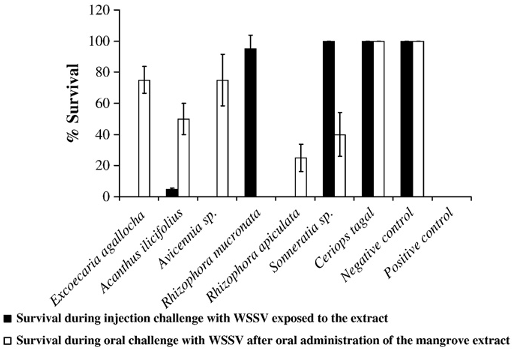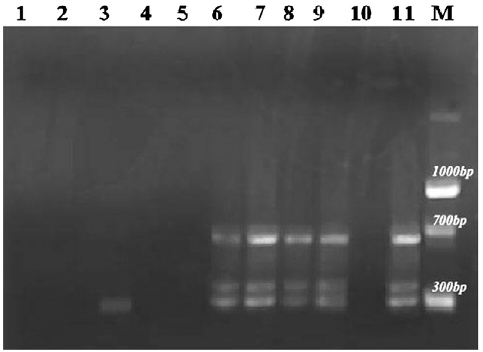Q2. What have the authors stated for future works in "In vivo screening of mangrove plants for anti wssv activity in penaeus monodon, and evaluation of ceriops tagal as a potential source of antiviral molecules" ?
As the aqueous extract from C. tagal alone could give protection to all animals tested against WSSV under the dual experimental conditions, C. tagal was identified for further studies. Further investigations are necessary in this direction. When shrimps were fed on the aqueous extract coated feed and subsequently challenged withWSSV, the viral DNA could not be detected in the tissue suggesting that the virus had neither invaded the host tissue nor multiplied. The virucidal property of the aqueous extracts of R. mucronata, Sonnaratia sp. and C. tagal when administered along with WSSV suspension at a 1:1 ratio after incubation for 3 h at room temperature suggested the presence of molecules in the preparation which could inactivate the virus.
Q3. What is the main bioactive group used as inhibitor of tumor cells?
Pentacyclic triterpenes have been considered as a major bioactive group used as inhibitor of tumor cells, induction of apoptosis and also in antiviral therapy of AIDS (He et al., 2007).
Q4. What are the main natural products isolated from C. tagal?
Diterpenes and triterpenes are the main natural products isolated from C. tagal (Zhang et al., 2005, Pakhathirathien et al., 2005, He et al., 2007).
Q5. What is the effect of sterols on the replication of herpex simplex virus?
Cardiac glycosides have been demonstrated to have an inhibitory activity on themultiplication of herpex simplex virus (Dodson et al., 2007).
Q6. What was the effective preparation to protect shrimp from WSSV?
On realizing the aqueous extract of C. tagal as the most effective preparation to protect shrimp from WSSV, it was subjected for HPLC analysis to generate HPLC fingerprint.
Q7. What is the effect of the aqueous extract on the WSSV?
Based on a dye test conducted initially and the data on the survival of shrimp subsequent to challenge following administration of the extract along with diet, it could be realized that the binder, 4% aqueous gelatin, used in this study could effectively deliver the active fractions to shrimp.
Q8. What was the aqueous extract of C. tagal?
The aqueous extract (500 ml) prepared from 50 g dried leaf of C. tagal yielded on average 3–4 g dry matter on lyophylization which contained the active fractions.
Q9. What test was used to determine the survival of shrimps exposed to WSSV?
The data generated on the survival of shrimp on administering the suspension of WSSV exposed to the plant extracts, and the data generated on the survival when challenged with WSSV subsequent to oral administration of the former were statistically analyzed employing the χ2 test.
Q10. What was the effect of the aqueous extract on shrimps?
When shrimps were fed on the aqueous extract coated feed and subsequently challenged withWSSV, the viral DNA could not be detected in the tissue suggesting that the virus had neither invaded the host tissue nor multiplied.
Q11. How many animals were tested for WSSV?
Confirmation of anti WSSV activityTo confirm the antiviral activity detected in the segregated plant species (C. tagal) intramuscular administration of virus suspension exposed to the plant extract, and oral administration of the plant extract and subsequent oral challenge were repeated in a batch of 24 animals and assayed by way of nested PCR.
Q12. How much of the extract was in the fed feed?
In their study, the quantity of the extract in the administered feed was nearly 1.0% of the total feed delivered at 500 mg/kg body weight per day.
Q13. What is the effect of the aqueous extract on the survival of shrimp?
Balasubramanian et al. (2008) on feeding 2% aqueous extract of C. dactylon coated feed to P. moodon could obtain 100% survival and the survived animals were PCR negative.
Q14. How was the WSSV in suspension tested?
Viability of WSSV in suspension was checked by injecting 10 μl to a batch of apparently healthy shrimp (6 nos) and mortality confirmed over a period of 3 to 7 days.
Q15. What was the significance of the WSSV test?
Under the second category of experiments, all the shrimps which were fed on the lyophilized aqueous extract of C. tagal could survive (100%) when orally challenged with WSSV (Pb0.001).
Q16. What was the effect of the aqueous extract on the shrimps?
The virucidal property of the aqueous extract of C. tagal was demonstrated through the total survival obtained on a challenge with the virus suspension exposed to the extract and the non infectivity of the tissue extracts of the ones that survived.
Q17. What is the antiviral activity of the C. tagal extract?
Based on these evidences the authors conclude that the antiviral activity of the C. tagal aqueous extract might be due to one of the above compounds or due to their synergistic action.
Q18. how many animals were nested PCR negative to WSSV?
Confirmation of anti WSSV activity in aqueous extract of C. tagalSubsequently, the antiviral activity of the aqueous extract of C. tagal was reexamined by repeating both the experiments in a batch of 24 animals and on completion of the experiment after 15 days the animals were nested PCR negative, and when a tissue extract was passaged onto a fresh batch of animals none of them showed anyclinical signs of WSSV infection and remained negative to nested PCR.




